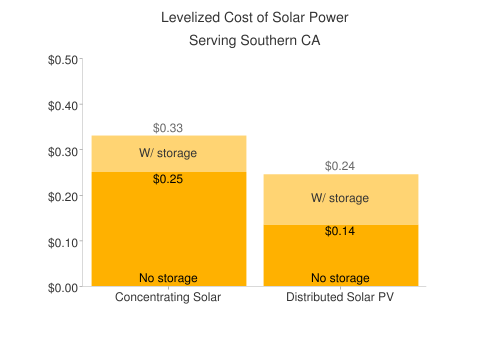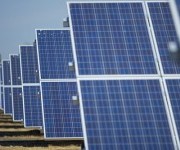Although both produce electricity from the sun, there are significant differences between solar photovoltaics (PV) and concentrating solar thermal electricity generation. This guide provides answers to the most pressing questions about the two solar technologies.
 1. Isn’t concentrating solar power cheaper?
1. Isn’t concentrating solar power cheaper?
No. Five years ago, the two technologies were relatively comparable, but in 2011 there’s no doubt that distributed solar PV is cheaper than concentrating solar power.
A concentrating solar power plant has a capital cost of $5.50 per watt without storage, and $7.75 per watt with six hours of thermal storage. The levelized cost of electricity from a Mohave Desert concentrating solar power plant (without storage) serving Southern California load is $250 per megawatt-hour (MWh), or 25 cents per kilowatt-hour (kWh).
In contrast, a distributed solar PV plant has a capital cost of $3.80 per watt without storage and can add battery storage for $0.50 per watt. Thus, a PV plant with six hours of storage would cost $6.80 per watt. Because a distributed solar PV plant also has no need for long-distance transmission, the levelized cost of solar PV (without storage) in Southern California is $136 per MWh, or 13.6 cents per kWh.
The levelized cost for concentrating solar and solar PV with storage are 33 and 24 cents per kWh, respectively.
We’ve also previously noted that a residential rooftop solar power system in Los Angeles has a lower levelized cost than any operational concentrating solar power plant in the world.
Sources:
- Powers, Bill. “Federal Government Betting on Wrong Solar Horse.” (Natural Gas & Electricity Journal, Dec. 2010).
- Distributed Concentrating Solar Thermal Power? Yes
- Home Solar Cheaper Than Every Concentrating Solar Power Plant
- Distributed, Small-Scale Solar Competes with Large-Scale PV
2. Doesn’t storage make concentrating solar better for the grid?
No. There are two reasons that storage does not give concentrating solar an edge over solar PV.
First, solar PV with battery storage has a lower levelized cost than concentrating solar with storage, given similar storage capacity.
Second, longer-term storage does not necessarily make concentrating solar more beneficial or economic. To quote Bill Powers from “Federal Government Betting on Wrong Solar Horse”:
Much of the electricity generated from the stored thermal energy would be produced at night during periods of low demand, when the solar thermal plant will be competing for market share with existing and much lower-cost nuclear, hydroelectric, natural gas combined-cycle, and some coal for decades to come.
In contrast, a strong economic case can be made for either solar thermal or PV plants to be equipped with limited storage to allow full capacity output during summertime peak demand periods when time-of-use power prices are high, assure reliability under all climatic conditions, and serve as non-spinning reserves. There is probably no economic case for building solar thermal plants or solar PV with more than two to three hours of storage until at least 2030. There is no economic justification now to equip a solar thermal plant so that it can convert high-value daytime peaking power into lowest-value off-peak power released between 10:00 p.m. and 6:00 a.m.
3. Can’t we get more solar power faster with concentrating solar?
No. Concentrating solar power capacity has scarcely reached 1 gigawatt, total, ever. Germany installed nearly 3 gigawatts of distributed solar PV in 2009 alone, over 80 percent of it on rooftops.
4. Is there any reason to do concentrating solar power?
Yes, if distributed. Concentrating solar thermal power can be used to co-generate electricity and heat for industrial use or air conditioning. However, for this to be practical, concentrating solar power plants need to be on-site or very close to their thermal energy users.


